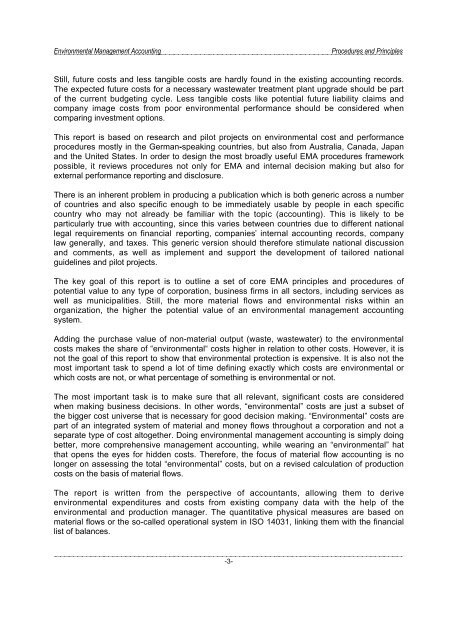Environmental Management Accounting Procedures and Principles
Environmental Management Accounting Procedures and Principles
Environmental Management Accounting Procedures and Principles
You also want an ePaper? Increase the reach of your titles
YUMPU automatically turns print PDFs into web optimized ePapers that Google loves.
<strong>Environmental</strong> <strong>Management</strong> <strong>Accounting</strong><br />
<strong>Procedures</strong> <strong>and</strong> <strong>Principles</strong><br />
Still, future costs <strong>and</strong> less tangible costs are hardly found in the existing accounting records.<br />
The expected future costs for a necessary wastewater treatment plant upgrade should be part<br />
of the current budgeting cycle. Less tangible costs like potential future liability claims <strong>and</strong><br />
company image costs from poor environmental performance should be considered when<br />
comparing investment options.<br />
This report is based on research <strong>and</strong> pilot projects on environmental cost <strong>and</strong> performance<br />
procedures mostly in the German-speaking countries, but also from Australia, Canada, Japan<br />
<strong>and</strong> the United States. In order to design the most broadly useful EMA procedures framework<br />
possible, it reviews procedures not only for EMA <strong>and</strong> internal decision making but also for<br />
external performance reporting <strong>and</strong> disclosure.<br />
There is an inherent problem in producing a publication which is both generic across a number<br />
of countries <strong>and</strong> also specific enough to be immediately usable by people in each specific<br />
country who may not already be familiar with the topic (accounting). This is likely to be<br />
particularly true with accounting, since this varies between countries due to different national<br />
legal requirements on financial reporting, companies’ internal accounting records, company<br />
law generally, <strong>and</strong> taxes. This generic version should therefore stimulate national discussion<br />
<strong>and</strong> comments, as well as implement <strong>and</strong> support the development of tailored national<br />
guidelines <strong>and</strong> pilot projects.<br />
The key goal of this report is to outline a set of core EMA principles <strong>and</strong> procedures of<br />
potential value to any type of corporation, business firms in all sectors, including services as<br />
well as municipalities. Still, the more material flows <strong>and</strong> environmental risks within an<br />
organization, the higher the potential value of an environmental management accounting<br />
system.<br />
Adding the purchase value of non-material output (waste, wastewater) to the environmental<br />
costs makes the share of “environmental“ costs higher in relation to other costs. However, it is<br />
not the goal of this report to show that environmental protection is expensive. It is also not the<br />
most important task to spend a lot of time defining exactly which costs are environmental or<br />
which costs are not, or what percentage of something is environmental or not.<br />
The most important task is to make sure that all relevant, significant costs are considered<br />
when making business decisions. In other words, “environmental” costs are just a subset of<br />
the bigger cost universe that is necessary for good decision making. “<strong>Environmental</strong>” costs are<br />
part of an integrated system of material <strong>and</strong> money flows throughout a corporation <strong>and</strong> not a<br />
separate type of cost altogether. Doing environmental management accounting is simply doing<br />
better, more comprehensive management accounting, while wearing an “environmental” hat<br />
that opens the eyes for hidden costs. Therefore, the focus of material flow accounting is no<br />
longer on assessing the total “environmental” costs, but on a revised calculation of production<br />
costs on the basis of material flows.<br />
The report is written from the perspective of accountants, allowing them to derive<br />
environmental expenditures <strong>and</strong> costs from existing company data with the help of the<br />
environmental <strong>and</strong> production manager. The quantitative physical measures are based on<br />
material flows or the so-called operational system in ISO 14031, linking them with the financial<br />
list of balances.<br />
-3-




